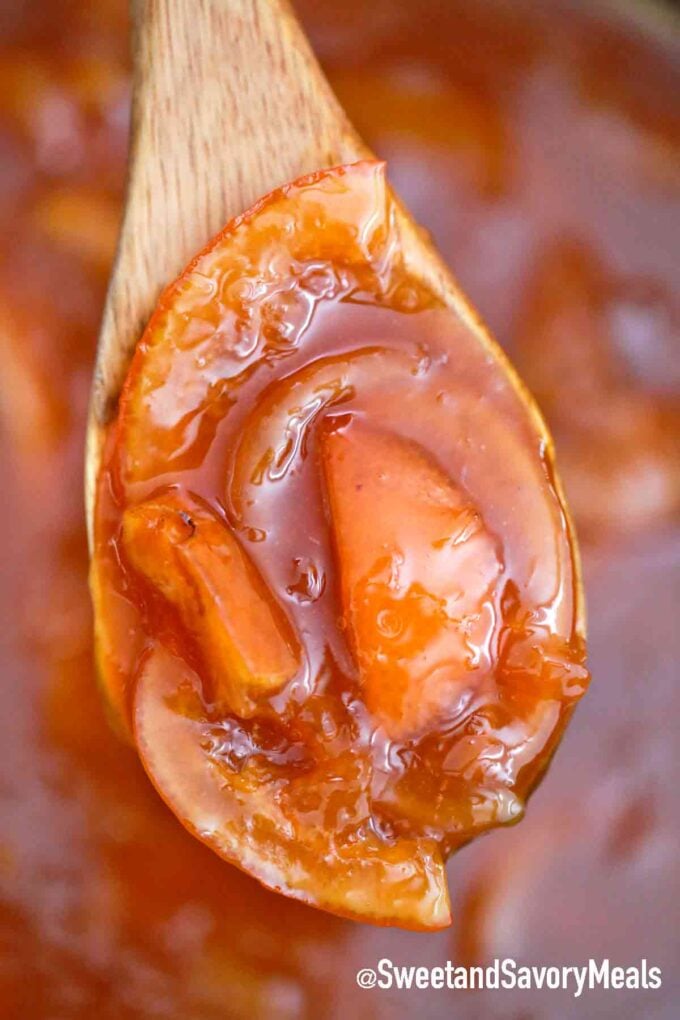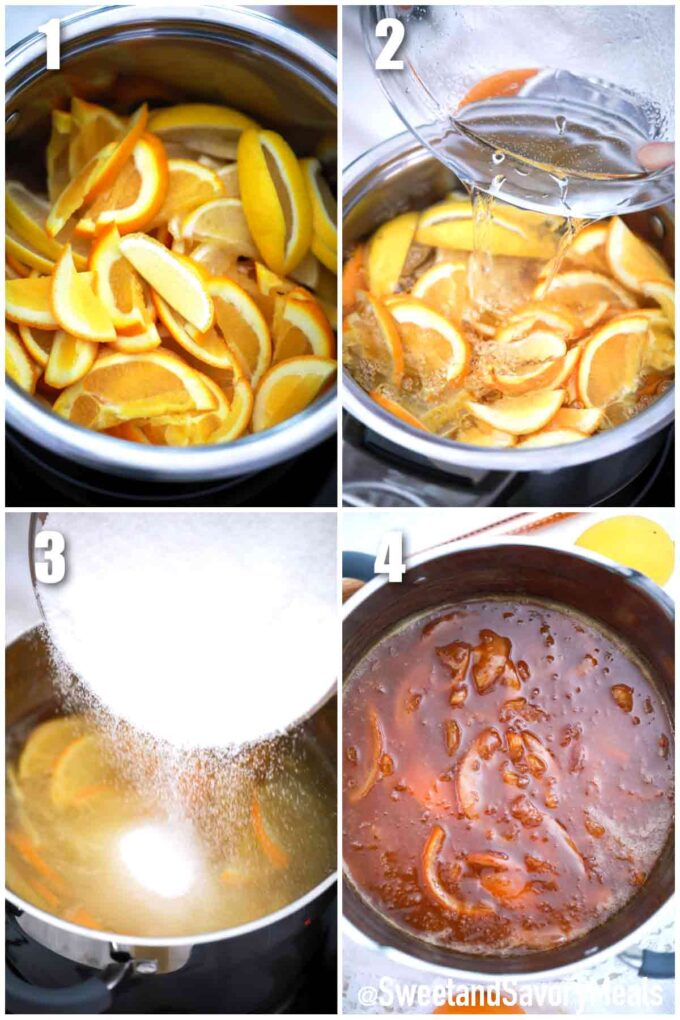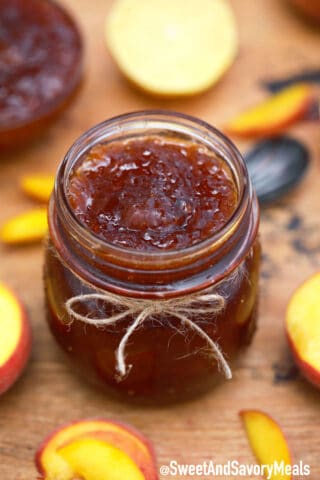Orange Marmalade Recipe
This Orange Marmalade has a sweet and tart flavor with a slight hint of bitterness that tastes wonderful on bread, desserts, or even stirred into savory dishes. The mix of lemons, oranges, sugar, and extracts makes the flavors shine no matter how you use it.

If you ask me my favorite citrus fruit, I will always say oranges without thinking twice. They are loaded with vitamin C, and I just love the flavor they add to anything I make. Over the years I have made so many orange recipes, like my orange sauce that we pour on almost everything in my house. If you love cooking with citrus the way I do, you should try my Instant Pot orange chicken or my cranberry orange chicken with honey and balsamic vinegar, which is a big favorite with my family.
Table of contents
My homemade orange marmalade makes about three quarts, which fills around a dozen 8-ounce jars. You can always cut the recipe in half or double it depending on how much you need. The sweet oranges and tangy lemons give it the best citrus flavor, and it is surprisingly easy to make. My favorite part is using the jars as little hostess gifts during the holidays because everyone loves a scoop of sunshine in the middle of fall and winter. After all, who can turn down a sweet dose of vitamin C?
Why you will love this recipe
- Homemade citrus sunshine in a jar: This orange marmalade is made with fresh oranges, tangy lemons, sugar, and a touch of extracts. It is simple to prepare and perfect for anyone who enjoys a bright, sweet, and tart spread.
- Big batch for sharing and saving: The recipe makes about a dozen jars, so there is plenty to enjoy and still have some left to share. It is a great way to stock the fridge or gift jars during the holidays.
- Sweet, tart, and a touch of bitter: The flavor has a nice balance without being too sugary. It tastes delicious on bread, desserts, or even paired with meats.
- Slow simmered the simple way: The cooking takes time, but it is easy and mostly hands-off. While it simmers, the kitchen fills with the scent of oranges and lemons until the marmalade thickens. Yum!
What you will need

- Large seedless oranges: I scrub the oranges really well before slicing.
- Lemons: I scrub the lemons too so the peel is clean and ready to use.
- Granulated sugar: I usually use regular sugar, but preserving sugar works too. It helps the marmalade set while keeping it sweet.
- Extracts: I like to use a little orange and vanilla extract. They make the flavor deeper and more fragrant.
- Water: I add seven cups of water to cook the fruit and sugar together. It slowly reduces as the marmalade thickens.
How to make
1. Prepare the fruit: I cut the oranges and lemons in half lengthwise and slice them very thin, removing all the seeds. Then I place the slices, along with their juices and small pieces, into a large pot.
2. Start the boil: I pour in the water and bring the pot to a boil over high heat. I stir often to keep the fruit from sticking as it cooks.

3. Sweeten and simmer: I take the pot off the heat and stir in the sugar until it fully dissolves, then cover it and let it rest overnight. The next day, I bring it back to a boil, lower the heat to simmer uncovered for two hours, then turn the heat to medium and let it cook for another 30 minutes, stirring often.
4. Check for doneness: While it cooks, I skim off any foam that rises and keep simmering until the marmalade reaches 220°F on a candy thermometer. To test, I place a little on a cold plate and chill it in the fridge; if it is firm but not hard, it is ready, and if it hardens too much, I stir in a splash of water. Once it is at the right consistency and a rich orange-gold color, I stir in the extracts.
5. Jar and serve: I carefully pour the hot marmalade into sterilized mason jars, wipe the rims clean with a damp paper towel, and seal them with canning lids. After chilling for 24 to 48 hours to let the pectin set, I spread the marmalade on bread or toast and store the rest in the pantry, or fridge until ready to use.
Expert tip
Slice citrus very thin
I always tell anyone making my orange marmalade to slice the oranges and lemons as thin as they can. Thin slices soften as they cook, melt right into the marmalade, and keep the texture smooth without tough bits of peel. I also like how the thin slices make the jars look extra pretty once the marmalade is done.
More tips to consider:
- I always use a candy thermometer when making marmalade. Guessing the temperature can throw off the texture, so checking for 220°F is important.
- I usually use regular seedless oranges, but Seville oranges also work if you like a stronger, slightly more bitter flavor.
- Marmalade often takes 24 to 48 hours to fully set. If it looks runny at first, I just check it again the next day.
- I spoon a little hot marmalade onto a chilled plate or one I’ve popped into the freezer. If it wrinkles when I slide a spoon across, it is ready; if not, I cook it a little longer.
- This recipe does not need store-bought pectin. Soaking the fruit overnight pulls the natural pectin out of the pith, which helps the marmalade set.
- If you do not have a boiling water canner for canning, you can use a big stainless-steel pot with a jar rack instead. Just add enough cups of water to submerge the jars about an inch under the surface.
Recipe variations and add-ins:
- Low sugar: I sometimes make a lighter version by using a baking mix that is half sugar and half sugar substitute. This keeps the flavor sweet without using all 8 cups of sugar.
- Sweeter: If I want a sweeter marmalade, I add up to 1 extra cup of sugar. It softens the natural bitter taste and makes the spread more dessert-like.
- Blood orange marmalade: I swap some or all of the oranges for blood oranges. They are a little tarter than navels and give the marmalade a beautiful deep color.
- Thicker: To thicken the marmalade, I mix 4 tablespoons of hot water with 2 tablespoons of cornstarch until smooth. I stir it into the marmalade while cooking for a firmer spread.
Serving suggestions
When I make a batch of orange marmalade, I usually set a few jars aside for family dinners and holidays. On Thanksgiving morning, I put it out with biscuits and breadsticks so everyone can snack while the turkey is in the oven.
For dinner parties, I like brushing the marmalade on one pot roasted chicken or pork, much like I do with my orange sauce. I have even used it as a sweet layer in oatmeal pancakes for breakfast and alongside my Instant Pot Mississippi pot roast for Christmas dinner, and it always gets compliments.
How to store leftovers:
- Store: I keep orange marmalade in the fridge for up to one month. If I process and seal it in sterilized mason jars, it lasts up to six months at room temperature, and once opened, it keeps for about a month in the fridge.
- Freeze: When I make extra jars, I store some in the freezer. They stay good for up to one year.
- Thaw: I move a frozen jar to the fridge the night before I need it. By the next day, it is ready to spread and enjoy.

Frequently asked questions
A little bitterness is natural because the peel is cooked into the marmalade. If it ever tastes too strong, I peel away some of the white pith before cooking or add up to an extra cup of sugar. My kids prefer the sweeter version, but I enjoy a bit of bitterness because it reminds me of the marmalade I grew up with.
When I do not have my thermometer handy, I use the plate test. I spoon a little marmalade onto a plate I keep in the freezer, wait a minute, and then nudge it with a spoon. If it wrinkles just slightly, I know it is ready to jar, and this little trick has saved me many times.
Yes, this recipe relies on the natural pectin found in the orange and lemon peels. That is why I always let the fruit soak overnight, because it draws the pectin into the mixture. I love that I can make marmalade without buying anything extra, and the texture still comes out thick and spreadable.

More jams and sauces:
Loved this recipe? I’d love to hear from you! 💛 Leave a 5-star rating ⭐️ in the recipe card below and share your thoughts in the comments – I read and appreciate every single one!
Let’s stay connected! Follow me on Facebook, Instagram, Pinterest, and YouTube for more delicious, sweet and savory recipes. Have a question? Ask in the comments, and I’ll be happy to help! 😊 with love Catalina!

Orange Marmalade Recipe
Ingredients
- 5 large seedless oranges about 3 1/2 – 4 pounds, scrubbed clean
- 2 lemons about 1/2 pound, scrubbed clean
- 8 cups water
- 8 cups white granulated sugar
- 1/2 teaspoon orange extract
- 1/2 teaspoon vanilla extract
Instructions
- Wash the fruits and cut in half crosswise, then into very thin half-moon slices.
- Discard any seeds and add the slices to a large stainless steel pot.
- Add water and bring the mixture to a boil, stirring often. Boil for 2-3 minutes.
- Remove the mixture from the heat and stir in the sugar until it dissolves. Cover, and let it stand overnight at room temperature.
- The next day, bring the mixture back to a boil over medium heat. Reduce heat to low and simmer uncovered for 2 1/2 hours, stirring from time to time.
- Skim off any foam that forms on the top.
- Cook the marmalade until it reaches 220 degrees. Test if the marmalade is ready, by placing a small amount on a plate and refrigerate it until it's cool, if it's neither runny nor hard, it's ready.
- If the marmalade is too runny, continue cooking it, and if it's hard, add a bit more water.
- When done cooking, stir in the extracts.
- Pour the marmalade into clean hot mason jars and seal with the lids.
- Chill in the refrigerator for 24-48 hours before using.
Notes
Slice citrus very thin
I always tell anyone making my orange marmalade to slice the oranges and lemons as thin as they can. Thin slices soften as they cook, melt right into the marmalade, and keep the texture smooth without tough bits of peel. I also like how the thin slices make the jars look extra pretty once the marmalade is done.More tips to consider:
- I always use a candy thermometer when making marmalade. Guessing the temperature can throw off the texture, so checking for 220°F is important.
- I usually use regular seedless oranges, but Seville oranges also work if you like a stronger, slightly more bitter flavor.
- Marmalade often takes 24 to 48 hours to fully set. If it looks runny at first, I just check it again the next day.
- I spoon a little hot marmalade onto a chilled plate or one I’ve popped into the freezer. If it wrinkles when I slide a spoon across, it is ready; if not, I cook it a little longer.
- This recipe does not need store-bought pectin. Soaking the fruit overnight pulls the natural pectin out of the pith, which helps the marmalade set.
- If you do not have a boiling water canner for canning, you can use a big stainless-steel pot with a jar rack instead. Just add enough cups of water to submerge the jars about an inch under the surface.




